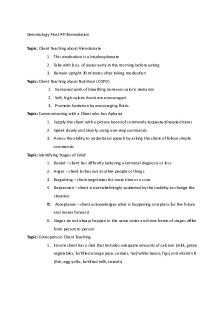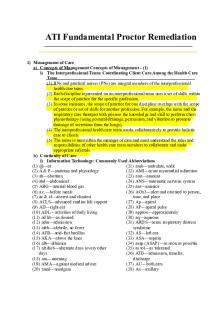ATI Remediation - Pharmacology 2020 PDF

| Title | ATI Remediation - Pharmacology 2020 |
|---|---|
| Author | autumn hawes |
| Course | Leadership and Management |
| Institution | South Dakota State University |
| Pages | 3 |
| File Size | 63.3 KB |
| File Type | |
| Total Downloads | 2 |
| Total Views | 147 |
Summary
remediation assignment after first attempt, 3pts per missed question...
Description
Emily Oswald Peds ATI Remediation Management of Care Case Management: Hematologic disorders – Sickle Cell - Encourage that patient rest, this will decrease oxygen needs - Make sure patient is thoroughly hydrated… will help prevent vaso occlusive crisis - Give pneumococcal conjugate vaccine (PCV), meningococcal vaccine, Haemophilus influenze type B vaccine (HIB) Collaboration with Interdisciplinary Team – head injury - Bulging fontanel, separation of cranial sutures, irritability, increased sleeping, highpitched cry, poor feeding & setting-sun sign --- all signs of increase ICP - Priority finding = increased ICP. - Medications that can assist with head injuries include: mannitol, antiepileptics, antibiotics, and analgesics Safety and Infection Control Standard Precautions/Transmission-Based Precautions/Surgical Asepsis: Pertussis - Initiate droplet precautions and use until 5 days after antibiotic is started - Small frequent feedings, fluids (might need IV if can’t take PO) - Try to avoid anything that may make the infant cry, can cause cyanotic spells Use of Restraints/Safety Devices: Safe med admin - Offer a nipple to allow an infant to suck the med when given orally - Offer sucrose pacifiers to infants with giving IM injections - Secure the child firmly to avoid movement of the needle and encourage parents to hold afterward Health Promotion and Maintenance Developmental Stages and Transitions: health promo adolescents - Enter a stage where they are able to pay attention and evaluate their thinking - Will finish growing and reach puberty - Erikson’s identity vs. role confusion: try different roles to figure out who they are Health Promotion/Disease Prevention: immunizations - 12mo immunization = PCV13, Hib, MMR, VAR, HepA - There is a possibility for anaphylaxis with every vaccination - Illness with or without fever are a reason to consider holding the vaccination Basic Care and Comfort Elimination: bowel elim - Adequate fiber - Adequate fluids - Bulk forming products before stool softeners, stimulants Nutrition and Oral Hydration: Phenylketonuria - Infants who are found to have phenylketonuria have to be placed on immediate strict diet - Make sure to monitor levels in breastfeeding infant and know that breastmilk may not be enough - Phenylketonuria is when phenylalanine builds up in the blood stream and tissues of an infant which can lead to cognitive impairment Pharmacological and Parenteral Therapies
Emily Oswald Peds ATI Remediation Dosage Calculation: admin ondansetron - Be aware of possible headache caused by med and need for analgesic - Monitor fluid/electrolyte status - Rare cases of tachy – monitor cardio status Medication Administration: MMR contra - Contraindications of receiving the MMR immunization include: pregnancy and breastfeeding - HepA: latex, HepB: yeast - IPV: neomycin Pharmacological Pain Management - Lidocaine-Prilocaine cream should be applied 1-2 hours prior to the procedure - Monitor patient closely for changes in vitals or cardio - Can have an allergic reaction! Reduction of Risk Potential Lab Values: adolescent type1 - DM is a contributor to a variety of health issue including cardiovascular disease, hypertension, renal failure, blindness, and stroke - HbA1c: should be b/w 4-5.9% - Priority findings: hunger, lightheaded/shaky, headache, anxious/irritable, Kussmal’s, sweating, tachy/palpitations, slurred speech, blurred vision, seizures Potential for Complication of Diagnostic Tests/Treatments/Procedures: trach cares - Surgical aseptic technique is required for suctioning, this prevents infection - Oral hygiene should be done for a trach q 2h - Occlusion can occur when the tube is clogged which makes air exchange difficult System Specific Assessments (blood neoplasms and health promo of preschoolers) ALL and lead poisoning - A child with ALL will show early symptoms of petechiae, enlarges lymph nodes, constipation, headache, vomiting, and unsteady gait - Children's blood lead levels increase the quickest at 6-12 months and reach peak levels at 18-24 months. - Lead poisoning can be asymptomatic which is why it is important to test in case emergent efforts need to be taken Physiological Adaptation Fluid and Electrolyte Imbalances - There are three types of dehydration: isotonic, hypotonic, hypertonic - Oral rehydration should be the first step for mild/moderate dehydration and can lead to parenteral fluids - Each diarrhea loss should be replaced with 10mL/kg Hemodynamics: HF - HF = unable to pump adequate blood to body and therefore cannot meet the demands the body needs both physical and metabolic - Defects are categorized by blood flow to the heart - Can be increased, decreased, obstructed or mixed ^ Alterations in Body Systems: patent ductus arteriosus
Emily Oswald Peds ATI Remediation -
The normal fetal circulation b/t the pulmonary artery and the aorta fails to close and results in increased pulmonary blood flow (left-to-right shunt) - Takes place in the upper area of the heart, should close on it’s own but in premature babies it often does not until later - Tetralogy of fallout = four defects that will cause the mixing of oxygenated and deoxygenated blood in the heart Illness Management (blood neoplasms, communicable diseases, HIV/AIDS) - Leukemia results in the increase of WBC’s (immature) with neoplastic characteristics which leads to infiltration of organs/tissues – ALL is the most common - Varicella/chicken pox start in center of body and spread outward, contagious until scabs have crusted over - Ensure thorough education to patients and parents about high-risk behaviors and possible ways to transmit the disease to others Medical Emergencies (acute and infectious respiratory illnesses and peds emergencies) - Acute and infectious respiratory illnesses include tonsillitis, nasopharyngitis, pharyngitis, croup syndromes, bacterial tracheitis, bronchitis, bronchiolitis, allergic rhinitis, and pneumonia - Epiglottitis – protect airway, keep everything out of mouth, prepare for intubation, humidified oxygen, droplet isolation - After a submersion injury --- respiratory assessment! Restless, tachy, sweating, nasal flaring, retractions, wheezing Pathophysiology (Hodgkin’s) - Enlarged lymph node usually in back of neck - Fever and night sweats, infection - Unplanned weight loss and fatigue...
Similar Free PDFs

ATI Remediation
- 9 Pages

NUR 232 ATI Remediation
- 7 Pages

ATI Pharmacology
- 11 Pages

Peds ATI Final Remediation
- 3 Pages

Gerontology ATI Remediation 1
- 2 Pages

Peds ATI remediation
- 9 Pages

ATI Maternal Newborn Remediation
- 22 Pages

APGAR Testing - ATI Remediation
- 1 Pages

Mental Health ATI Remediation
- 3 Pages

ATI pharmacology proctored ATI 2019
- 20 Pages

ATI Proctor Fund Remediation
- 25 Pages

ATI Remediation FOR Fundamentals
- 9 Pages

Maternal ati remediation
- 6 Pages
Popular Institutions
- Tinajero National High School - Annex
- Politeknik Caltex Riau
- Yokohama City University
- SGT University
- University of Al-Qadisiyah
- Divine Word College of Vigan
- Techniek College Rotterdam
- Universidade de Santiago
- Universiti Teknologi MARA Cawangan Johor Kampus Pasir Gudang
- Poltekkes Kemenkes Yogyakarta
- Baguio City National High School
- Colegio san marcos
- preparatoria uno
- Centro de Bachillerato Tecnológico Industrial y de Servicios No. 107
- Dalian Maritime University
- Quang Trung Secondary School
- Colegio Tecnológico en Informática
- Corporación Regional de Educación Superior
- Grupo CEDVA
- Dar Al Uloom University
- Centro de Estudios Preuniversitarios de la Universidad Nacional de Ingeniería
- 上智大学
- Aakash International School, Nuna Majara
- San Felipe Neri Catholic School
- Kang Chiao International School - New Taipei City
- Misamis Occidental National High School
- Institución Educativa Escuela Normal Juan Ladrilleros
- Kolehiyo ng Pantukan
- Batanes State College
- Instituto Continental
- Sekolah Menengah Kejuruan Kesehatan Kaltara (Tarakan)
- Colegio de La Inmaculada Concepcion - Cebu


